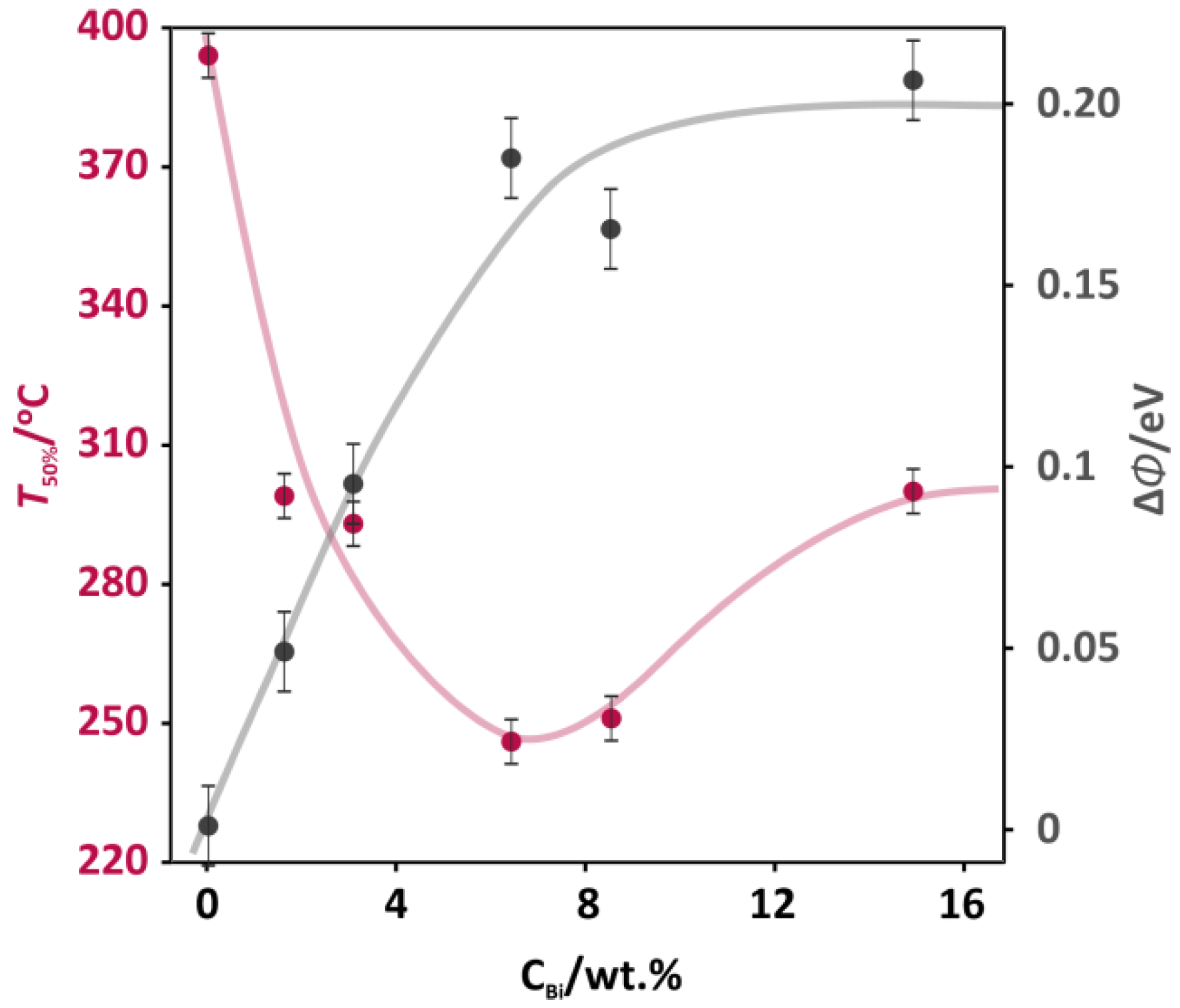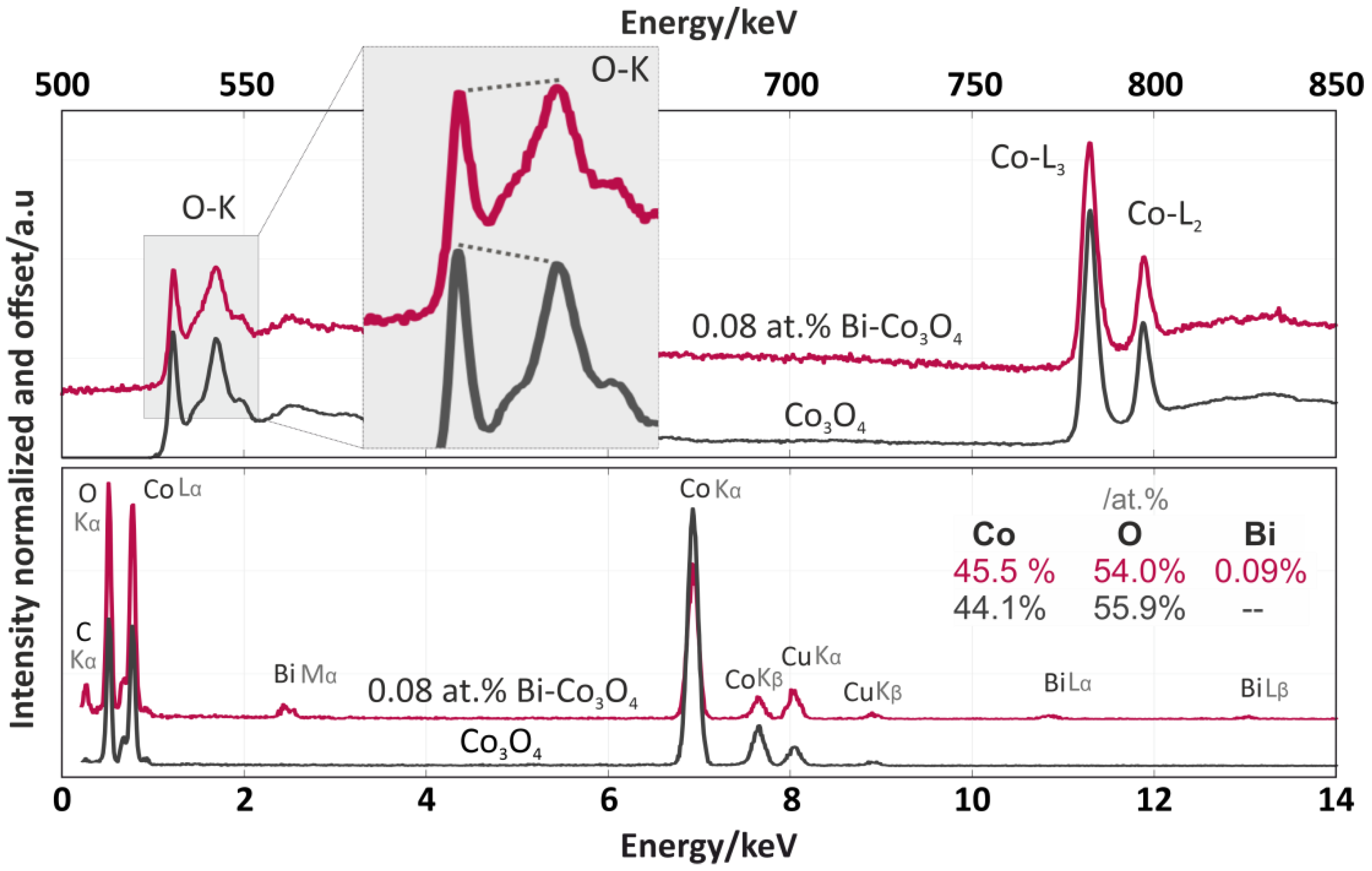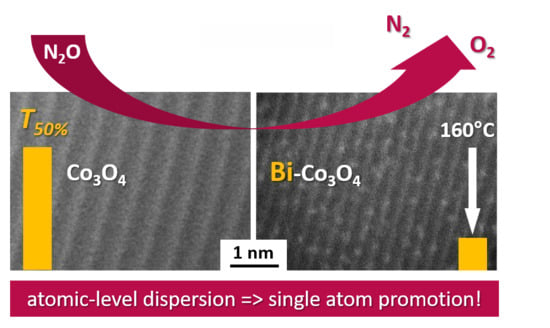Atomic-Level Dispersion of Bismuth over Co3O4 Nanocrystals—Outstanding Promotional Effect in Catalytic DeN2O
Abstract
:1. Introduction
2. Results and Discussion
2.1. Catalytic Activity and Work Function Measurements
2.2. Physicochemical Characterization
2.3. High-Resolution Microscopy and Spectroscopy
3. Materials and Methods
3.1. Synthesis of Co3O4-Based Catalysts
3.2. DeN2O Tests and Work Function Measurements
3.3. Physicochemical Characterization
3.4. High-Resolution Microscopy and Spectroscopy
4. Conclusions
Author Contributions
Funding
Acknowledgments
Conflicts of Interest
Appendix A
References
- Reducing Global Health Risk. Through Mitigation of Short-Lived Climate Pollutants Scoping Report for Policymakers; World Health Organization: Geneva, Switzerland, 2015.
- Inventory of Greenhouse Gas Emissions and Sinks: 1990–2016; Environmental Protection Agency: Washington, DC, USA, 2018.
- Denisovа, K.O.; Ilyin, A.A.; Rumyantsev, R.N.; Ilyin, A.P.; Volkova, A.V. Nitrous Oxide: Production, Application, and Protection of the Environment. Russ. J. Gen. Chem. 2019, 89, 46–54. [Google Scholar] [CrossRef]
- Global Warming Potential Values. Available online: https://www.ghgprotocol.org/sites/default/files/ghgp/Global-Warming-Potential-Values%20%28Feb%2016%202016%29_1.pdf (accessed on 22 March 2020).
- Drawing Down N2O To Protect Climate and the Ozone Layer A UNEP Synthesis Report; United Nations Environment Programme (UNEP): Nairobi, Kenya, 2013.
- Nitrous Oxide Market Size & Share|Global Industry Report, 2018–2025. Available online: https://www.grandviewresearch.com/industry-analysis/nitrous-oxide-market (accessed on 4 March 2020).
- Ek, M.; Tjus, K. Destruction of Medical N2O in Sweden. Greenhouse Gases—Capturing, Utilization and Reduction; InTech: London, UK, 2012. [Google Scholar]
- Husum, B.; Stenqvist, O.; Alahuhta, S.; Sigurdsson, G.H.; Dale, O. Current use of nitrous oxide in public hospitals in Scandinavian countries. Acta Anaesthesiol. Scand. 2013, 57, 1131–1137. [Google Scholar] [CrossRef] [PubMed]
- Konsolakis, M. Recent Advances on Nitrous Oxide (N2O) Decomposition over Non-Noble-Metal Oxide Catalysts: Catalytic Performance, Mechanistic Considerations, and Surface Chemistry Aspects. ACS Catal. 2015, 5, 6397–6421. [Google Scholar] [CrossRef]
- Obalová, L.; Pacultová, K.; Balabánová, J.; Jirátová, K.; Bastl, Z.; Valášková, M.; Lacný, Z.; Kovanda, F. Effect of Mn/Al ratio in Co-Mn-Al mixed oxide catalysts prepared from hydrotalcite-like precursors on catalytic decomposition of N2O. Catal. Today 2007, 119, 233–238. [Google Scholar] [CrossRef]
- Kaczmarczyk, J.; Zasada, F.; Janas, J.; Indyka, P.; Piskorz, W.; Kotarba, A.; Sojka, Z. Thermodynamic Stability, Redox Properties, and Reactivity of Mn3O4, Fe3O4, and Co3O4 Model Catalysts for N2O Decomposition: Resolving the Origins of Steady Turnover. ACS Catal. 2016, 6, 1235–1246. [Google Scholar] [CrossRef]
- Abu-Zied, B.M.; Asiri, A.M. The role of alkali promoters in enhancing the direct N2O decomposition reactivity over NiO catalysts. Cuihua Xuebao/Chin. J. Catal. 2015, 36, 1837–1845. [Google Scholar] [CrossRef]
- Gudyka, S.; Grzybek, G.; Gryboś, J.; Indyka, P.; Leszczyński, B.; Kotarba, A.; Sojka, Z. Enhancing the deN2O activity of the supported Co3O4|α-Al2O3 catalyst by glycerol-assisted shape engineering of the active phase at the nanoscale. Appl. Catal. B Environ. 2017, 201, 339–347. [Google Scholar] [CrossRef]
- Wójcik, S.; Grzybek, G.; Stelmachowski, P.; Sojka, Z.; Kotarba, A. Bulk, Surface and Interface Promotion of Co3O4 for the Low-Temperature N2O Decomposition Catalysis. Catalysts 2019, 10, 41. [Google Scholar] [CrossRef] [Green Version]
- Rico-Pérez, V.; Kotarba, A.; Sojka, Z.; Indyka, P.; Guillén-Hurtado, N.; Bueno-López, A.; Grzybek, G.; Gudyka, S.; Stelmachowski, P. Strong dispersion effect of cobalt spinel active phase spread over ceria for catalytic N2O decomposition: The role of the interface periphery. Appl. Catal. B Environ. 2015, 180, 622–629. [Google Scholar]
- Grzybek, G.; Ciura, K.; Wójcik, S.; Gryboś, J.; Indyka, P.; Inger, M.; Antoniak-Jurak, K.; Kowalik, P.; Kotarba, A.; Sojka, Z. On the selection of the best polymorph of Al2O3 carriers for supported cobalt nano-spinel catalysts for N2O abatement: An interplay between preferable surface spreading and damaging active phase-support interaction. Catal. Sci. Technol. 2017, 7, 5723–5732. [Google Scholar] [CrossRef]
- Grzybek, G.; Wójcik, S.; Legutko, P.; Gryboś, J.; Indyka, P.; Leszczyński, B.; Kotarba, A.; Sojka, Z. Thermal stability and repartition of potassium promoter between the support and active phase in the K-Co2.6Zn0.4O4|α-Al2O3catalyst for N2O decomposition: Crucial role of activation temperature on catalytic performance. Appl. Catal. B Environ. 2017, 205, 597–604. [Google Scholar] [CrossRef]
- Denton, A.R.; Ashcroft, N.W. Vegard’s Law. Phys Rev A 1991, 43, 3161–3164. [Google Scholar] [CrossRef] [PubMed]
- Tolman, W.B. Binding and activation of N2O at transition-metal centers: Recent mechanistic insights. Angew. Chem. Int. Ed. 2010, 49, 1018–1024. [Google Scholar] [CrossRef] [PubMed] [Green Version]
- Piskorz, W.; Zasada, F.; Stelmachowski, P.; Kotarba, A.; Sojka, Z. Decomposition of N2O over the surface of cobalt spinel: A DFT account of reactivity experiments. Catal. Today 2008, 137, 418–422. [Google Scholar] [CrossRef]
- Wójcik, S.; Indyka, P.; Sojka, Z.; Kotarba, A. Development of structured Co3O4-based catalyst for N2O removal from hospital ventilation systems. Catal. Today 2019. [CrossRef]
- Shang, Z.; Sun, M.; Chang, S.; Che, X.; Cao, X.; Wang, L.; Guo, Y.; Zhan, W.; Guo, Y.; Lu, G. Activity and stability of Co3O4-based catalysts for soot oxidation: The enhanced effect of Bi2O3 on activation and transfer of oxygen. Appl. Catal. B Environ. 2017, 209, 33–44. [Google Scholar] [CrossRef]
- Lou, Y.; Ma, J.; Cao, X.; Wang, L.; Dai, Q.; Zhao, Z.; Cai, Y.; Zhan, W.; Guo, Y.; Hu, P.; et al. Promoting Effects of In2O3 on Co3O4 for CO Oxidation: Tuning O2 Activation and CO Adsorption Strength Simultaneously. ACS Catal. 2014, 4, 4143–4152. [Google Scholar] [CrossRef]
- XPS Interpretation of Bishmuth. Available online: https://xpssimplified.com/elements/bismuth.php (accessed on 4 March 2020).
- Yamashita, S.; Kikkawa, J.; Yanagisawa, K.; Nagai, T.; Ishizuka, K.; Kimoto, K. Atomic number dependence of Z contrast in scanning transmission electron microscopy. Sci. Rep. 2018, 8, 1–7. [Google Scholar] [CrossRef]
- Shannon Radii. Available online: http://abulafia.mt.ic.ac.uk/shannon/ptable.php (accessed on 4 March 2020).
- Srinivasa Rao, N.; Srinivasa Rao, L.; Srinivasa Rao, C.; Raghavaiah, B.V.; Ravi Kumar, V.; Brik, M.G.; Veeraiah, N. Influence of valence states and co-ordination of cobalt ions on dielectric properties of PbOBi2O3As2O3:CoO glass system. Phys. B Condens. Matter 2012, 407, 581–588. [Google Scholar] [CrossRef]
- Zhang, Z. Surface effects in the energy loss near edge structure of different cobalt oxides. Ultramicroscopy 2007, 107, 598–603. [Google Scholar] [CrossRef]
- Zhao, Y.; Feltes, T.E.; Regalbuto, J.R.; Meyer, R.J.; Klie, R.F. In situ electron energy loss spectroscopy study of metallic Co and Co oxides. J. Appl. Phys. 2010, 108, 063704. [Google Scholar] [CrossRef]
- Inger, M.; Wilk, M.; Saramok, M.; Grzybek, G.; Grodzka, A.; Stelmachowski, P.; Makowski, W.; Kotarba, A.; Sojka, Z. Cobalt spinel catalyst for N2O abatement in the pilot plant operation-long-term activity and stability in tail gases. Ind. Eng. Chem. Res. 2014, 53, 10335–10342. [Google Scholar] [CrossRef]
- EUROKIN_fixed-bed_html, EUROKIN spreadsheet on requirements for measurement of intrinsic kinetics in the gas-solid fixed-bed reactor. Available online: https://www.eurokin.org/wp-content/uploads/webtool/EUROKIN_fixed-bed_html.htm (accessed on 22 March 2020).






| Sample | Nominal Concentration of Bi (wt %) | Experimental Concentration of Bi (wt %) | Surface Concentration of Bi (at. %) | SSA (m2 g−1) | Co3O4 Crystals Size by the W–H Method (nm) |
|---|---|---|---|---|---|
| 1 | 0 | 0 | 0 | 33.1 | 56 |
| 2 | 1.7 | 1.7 ± 0.3 | 1.8 | 32.3 | 47 |
| 3 | 3.4 | 3.4 ± 0.2 | 2.1 | 43.0 | 38 |
| 4 | 6.6 | 6.6 ± 0.4 | 3.7 | 57.7 | 24 |
| 5 | 8.2 | 9.0 ± 0.3 | - | 80.8 | 14 |
| 6 | 15.4 | 14.6 ± 0.6 | 3.7 | 53.7 | 28 |
| d-Spacing Plane | Theoretical Distances for Bulk Spinel (Å) | * Measured Distances for Co3O4 (Å) | * Measured Distances for 0.08Bi-Co3O4 (Å) |
|---|---|---|---|
| 111 | 4.67 | 4.72 ± 0.04 | 4.71 ± 0.05 |
| 200 | 4.04 | 4.09 ± 0.02 | 4.06 ± 0.01 |
| 210 | 3.62 | 3.58 ± 0.01 | 3.65 ± 0.01 |
| 220 | 2.86 | 2.88 ± 0.01 | 2.89 ± 0.01 |
| 310 | 2.56 | 2.53 ± 0.01 | 2.54 ± 0.01 |
| 311 | 2.44 | 2.45 ± 0.01 | 2.45 ± 0.02 |
© 2020 by the authors. Licensee MDPI, Basel, Switzerland. This article is an open access article distributed under the terms and conditions of the Creative Commons Attribution (CC BY) license (http://creativecommons.org/licenses/by/4.0/).
Share and Cite
Wójcik, S.; Thersleff, T.; Gębska, K.; Grzybek, G.; Kotarba, A. Atomic-Level Dispersion of Bismuth over Co3O4 Nanocrystals—Outstanding Promotional Effect in Catalytic DeN2O. Catalysts 2020, 10, 351. https://doi.org/10.3390/catal10030351
Wójcik S, Thersleff T, Gębska K, Grzybek G, Kotarba A. Atomic-Level Dispersion of Bismuth over Co3O4 Nanocrystals—Outstanding Promotional Effect in Catalytic DeN2O. Catalysts. 2020; 10(3):351. https://doi.org/10.3390/catal10030351
Chicago/Turabian StyleWójcik, Sylwia, Thomas Thersleff, Klaudia Gębska, Gabriela Grzybek, and Andrzej Kotarba. 2020. "Atomic-Level Dispersion of Bismuth over Co3O4 Nanocrystals—Outstanding Promotional Effect in Catalytic DeN2O" Catalysts 10, no. 3: 351. https://doi.org/10.3390/catal10030351







